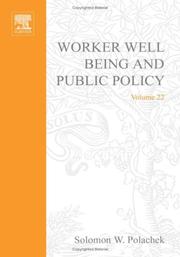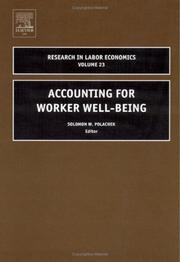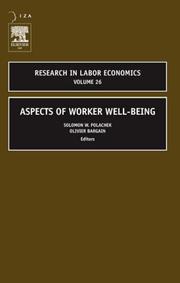| Listing 1 - 10 of 29 | << page >> |
Sort by
|

ISBN: 9781849502139 1849502137 076231026X 9786611022549 1281022543 0080521754 9780080521756 9780762310265 Year: 2009 Volume: v. 22 Publisher: Bingley Emerald Group Publishing Limited
Abstract | Keywords | Export | Availability | Bookmark
 Loading...
Loading...Choose an application
- Reference Manager
- EndNote
- RefWorks (Direct export to RefWorks)
This volume contains 15 essays devoted to a number of multifaceted issues regarding how public policy affects worker well-being. Of the 15 chapters, the first two are the more general, dealing with overall earnings distribution and overall changes in welfare policy. The remaining chapters examine specific aspects of human welfare. They cover: fertility, disability, minimum wage, pension wealth, human capital investment, migration, health, and earnings. The book culminates with four chapters relating to gender and the family. Ultimately, determining who works, how much is earned, and how these earnings get distributed define the components of individual and social welfare. The topics covered in this volume shed light on these questions.
Labor policy. --- Labor force. --- Labor supply. Wages. Income distribution. Labor policy. --- Welfare policy. --- Labor supply. --- Wages. --- Income distribution. --- Labor --- State and labor --- Economic policy --- Distribution of income --- Income inequality --- Inequality of income --- Distribution (Economic theory) --- Disposable income --- Compensation --- Departmental salaries --- Earnings --- Pay --- Remuneration --- Salaries --- Wage-fund --- Wage rates --- Working class --- Income --- Labor costs --- Compensation management --- Cost and standard of living --- Prices --- Labor force --- Labor force participation --- Labor pool --- Work force --- Workforce --- Labor market --- Human capital --- Labor mobility --- Manpower --- Manpower policy --- Government policy --- Wages --- Salaires --- Revenu --- Travail --- Répartition --- Politique gouvernementale --- Labor supply --- Income distribution --- Labor policy --- E-books --- Business & Economics --- Labour economics. --- Central government policies. --- Labor economics. --- Money & Monetary Policy. --- Economics

ISBN: 1281015881 9786611015886 0080471765 9780080471761 9781849502733 1849502730 076231110X 9780762311101 Year: 2009 Publisher: Bingley Emerald Group Publishing Limited
Abstract | Keywords | Export | Availability | Bookmark
 Loading...
Loading...Choose an application
- Reference Manager
- EndNote
- RefWorks (Direct export to RefWorks)
This volume comprises 12 chapters, each accounting for a particular aspect of worker well-being. Among the issues addressed are: employee compensation, job loss, disability, health, gender, education, contract negotiation, and macroeconomic labor policy. The volume provides answers to a number of important questions. For example, why do smaller, newer companies better match CEO pay to profits than old, established corporations? Which demographic groups are most prone to job losses? What does marital status have to do with the glass ceiling? Does retiring from work increase one's mental health? Does domestic violence drive women to work more? Do higher educational subsidies lead to more schooling than larger educational rates of return? In short, the volume addresses a number of important policy-related research issues on worker well-being facing labor economists today.
Job satisfaction. --- Employees. --- Work --- Wages. --- Psychological aspects. --- Compensation --- Departmental salaries --- Earnings --- Pay --- Remuneration --- Salaries --- Wage-fund --- Wage rates --- Working class --- Work, Psychology of --- Laborers --- Personnel --- Workers --- Occupational satisfaction --- Work satisfaction --- Wages --- Income --- Labor costs --- Compensation management --- Cost and standard of living --- Prices --- Persons --- Industrial relations --- Personnel management --- Quality of work life --- Satisfaction --- Job enrichment --- Labor market --- Social accounting --- Employee fringe benefits --- Women employees --- Labor policy --- E-books --- Labor --- State and labor --- Economic policy --- Female employees --- Women workers --- Working women --- Workingwomen --- Employees --- Benefits, Employee --- Benefits, Fringe --- Employee benefits --- Fringe benefits --- Non-wage payments --- Perks (Employee fringe benefits) --- Perquisites (Employee fringe benefits) --- Corporate social accounting --- Social auditing --- Socio-economic accounting --- Socioeconomic accounting --- Accounting --- National income --- Quality of life --- Social indicators --- Market, Labor --- Supply and demand for labor --- Markets --- Government policy --- Supply and demand --- Business & Economics --- Labour economics. --- Labor economics. --- Labor supply --- Management. --- Economics
Book
Year: 1972 Publisher: Leiden Sijthoff
Abstract | Keywords | Export | Availability | Bookmark
 Loading...
Loading...Choose an application
- Reference Manager
- EndNote
- RefWorks (Direct export to RefWorks)
Book
Year: 1978 Publisher: Tübingen Mohr
Abstract | Keywords | Export | Availability | Bookmark
 Loading...
Loading...Choose an application
- Reference Manager
- EndNote
- RefWorks (Direct export to RefWorks)
Book
Year: 1971 Publisher: Princeton International Finance Section
Abstract | Keywords | Export | Availability | Bookmark
 Loading...
Loading...Choose an application
- Reference Manager
- EndNote
- RefWorks (Direct export to RefWorks)
Book
Year: 1957 Publisher: New York Paine-Whitman
Abstract | Keywords | Export | Availability | Bookmark
 Loading...
Loading...Choose an application
- Reference Manager
- EndNote
- RefWorks (Direct export to RefWorks)
Book
ISBN: 1783500565 1783500573 9781783500574 9781783500567 Year: 2013 Publisher: United Kingdom : Emerald Group Publishing Limited,
Abstract | Keywords | Export | Availability | Bookmark
 Loading...
Loading...Choose an application
- Reference Manager
- EndNote
- RefWorks (Direct export to RefWorks)
This volume contains new important research on worker well-being in a changing economy. Topics include employee compensation, human capital investment, womens wages, unemployment, and the effects of government policies. Among the questions answered are: Does free-trade (particularly regarding NAFTA) affect womens wages relative to mens? Can guaranteeing college scholarships raise high school students grade-point averages? Does increasing wage dispersion within a plant induce workers to put out more effort; or does it decrease commradery among employees, thereby lowering productivity? Does deferring worker pay really affect productivity on the job? Do firms manipulate fringe benefits (job characteristics) to adequately compensate workers for dangerous jobs? Do business cycles influence the terms of effort-enhancing labor contracts? How can workers signal their potential quality when displaced by plant closings? How severe are the detrimental effects of long-term joblessness? And finally, how do changes in welfare laws affect recipients time allocation at home?
Business & Economics --- Labor & Workers' Economics --- Job satisfaction. --- Wages. --- Employee motivation. --- Unemployment. --- Work environment. --- Labor supply. --- Income distribution. --- Labor policy. --- Labor --- State and labor --- Distribution of income --- Income inequality --- Inequality of income --- Labor force --- Labor force participation --- Labor pool --- Work force --- Workforce --- Climate, Workplace --- Environment, Work --- Places of work --- Work places --- Working conditions, Physical --- Working environment --- Workplace --- Workplace climate --- Workplace environment --- Worksite environment --- Joblessness --- Motivation in industry --- Work motivation --- Compensation --- Departmental salaries --- Earnings --- Pay --- Remuneration --- Salaries --- Wage-fund --- Wage rates --- Working class --- Occupational satisfaction --- Work satisfaction --- Government policy --- Wages --- Economic policy --- Distribution (Economic theory) --- Disposable income --- Labor market --- Human capital --- Labor mobility --- Manpower --- Manpower policy --- Environmental engineering --- Industrial engineering --- Employment (Economic theory) --- Full employment policies --- Labor supply --- Right to labor --- Underemployment --- Motivation (Psychology) --- Personnel management --- Psychology, Industrial --- Goal setting in personnel management --- Income --- Labor costs --- Compensation management --- Cost and standard of living --- Prices --- Quality of work life --- Satisfaction --- Job enrichment --- Labor economics --- E-books --- Economics --- Economic sociology --- Labour economics. --- Economics. --- Labor economics. --- Labor.

ISBN: 1281004006 9786611004002 0080475507 9780080475509 9781849504737 1849504733 0762313900 9780762314249 9780762313907 Year: 2007 Publisher: Amsterdam ; Boston : Elsevier JAI,
Abstract | Keywords | Export | Availability | Bookmark
 Loading...
Loading...Choose an application
- Reference Manager
- EndNote
- RefWorks (Direct export to RefWorks)
This volume contains thirteen new and original chapters on topics relating to worker well-being. It deals directly with how economic institutions affect individual and family earnings distributions. Topics covered include job training, worker and firm mobility, unions, collective bargaining, minimum wages, unemployment insurance and schooling. Among the questions answered are: To what extent do greater work hours of women mitigate the widening of the family earnings distribution? To what extent does the decline in unionization widen the distribution of earnings? To what extent do computers expand the earnings distribution? To what extent does the Russian wage distribution change if one accounted for wage arrears? To what extent does business relocation bring about job creation and job destruction? To what extent does maternal education increase childrens education? To what extent do job skills matter for low-income workers? And finally, why do minimum wage increases often fail to lead to increases in unemployment? There are thirteen new and original chapters containing research on aspects of worker well-being. Each chapter is written by experts in the field.
Labor economics. --- Business & Economics --- Labor & Workers' Economics --- Labor economics --- Income distribution --- Wages --- Labor supply --- Work environment --- E-books --- Compensation --- Departmental salaries --- Earnings --- Pay --- Remuneration --- Salaries --- Wage-fund --- Wage rates --- Working class --- Income --- Labor costs --- Compensation management --- Cost and standard of living --- Prices --- Distribution of income --- Income inequality --- Inequality of income --- Distribution (Economic theory) --- Disposable income --- Economics --- Climate, Workplace --- Environment, Work --- Places of work --- Work places --- Working conditions, Physical --- Working environment --- Workplace --- Workplace climate --- Workplace environment --- Worksite environment --- Environmental engineering --- Industrial engineering --- Labor force --- Labor force participation --- Labor pool --- Work force --- Workforce --- Labor market --- Human capital --- Labor mobility --- Manpower --- Manpower policy --- Science --- Labour economics. --- General. --- Income distribution. --- Wages. --- Labor supply. --- Work environment.
Book
ISBN: 1283869039 1781903581 9781781903582 1781903573 9781283869034 Year: 2012 Volume: v. 36 Publisher: Bingley : Emerald,
Abstract | Keywords | Export | Availability | Bookmark
 Loading...
Loading...Choose an application
- Reference Manager
- EndNote
- RefWorks (Direct export to RefWorks)
This volume contains eight new and innovative research articles relevant to researchers and policy makers. Each chapter deals with an aspect of human welfare and is authored by an expert in the field. One deals with how technological change affects the distribution of earnings, two deal with how workers advance through corporate hierarchy, four deal with how incentives motivate workers, and the final chapter deals with how one immigrant group is far more successful than even the native population. Among the questions answered are: What accounts for the relative rise in skilled worker salaries? Which workers advance more quickly up the corporate ladder? Are workers hired from outside the company as successful as internally promoted workers? Does performance-based pay affect worker absenteeism? Do retirement incentives to workers really help the firm? Do unexpected decreases in retirement income decrease retiree life satisfaction? Do more stringent divorce laws increase cohabitation? What causes immigrants to really succeed in their new country?.
Labor economics. --- Economics. --- Economic theory --- Political economy --- Social sciences --- Economic man --- Economics --- Labor economics --- E-books --- Business & Economics --- Economics of industrial organisation. --- Labour economics. --- Labor.
Book
ISBN: 9781787564626 9781787564619 9781787564633 1787564614 1787564630 1787564622 Year: 2018 Volume: 46 Publisher: Bingley : Emerald,
Abstract | Keywords | Export | Availability | Bookmark
 Loading...
Loading...Choose an application
- Reference Manager
- EndNote
- RefWorks (Direct export to RefWorks)
Understanding the factors that affect how one transitions from school to the labor market and finally to retirement isimportant both to the individual and to the policy maker. This volume containsseven original and innovative articles that analyze aspects of such labormarket transitions. Questions answered include: How did hiring and firingdecisions change for blacks and Hispanics relative to whites in the GreatRecession? Can redesigning the minimum wage lead to more efficient employmenttransitions and greater social welfare? What are the factors leading a companyto fast-track an employee? How does the number of layers in a companyshierarchical structure affect ones ability to be promoted? Do women gravitateto more socially caring occupations because they care more than men? Doesgaming among youth increase math scores more for boys than girls? And, doesgood health impede ones inclination to retire?
Labour market --- Labor market --- Employees --- Market, Labor --- Supply and demand for labor --- Markets --- Supply and demand --- E-books --- Labor market. --- Employee selection. --- Retirees. --- Business & Economics / Personal Finance / Retirement Planning. --- Retirement. --- Dismissal of. --- Downsizing of organizations --- Dismissal of employees --- Employee dismissal --- Employees, Dismissal of --- Employment termination --- Firing of employees --- Notice of dismissal --- Termination of employment --- Personnel management --- Employees, Selection of --- Hiring of employees --- Personnel selection --- Selection of employees --- Selection of personnel --- Persons --- People, Retired --- Retired people --- Retired persons --- Hiring --- Selection and appointment
| Listing 1 - 10 of 29 | << page >> |
Sort by
|

 Search
Search Feedback
Feedback About UniCat
About UniCat  Help
Help News
News